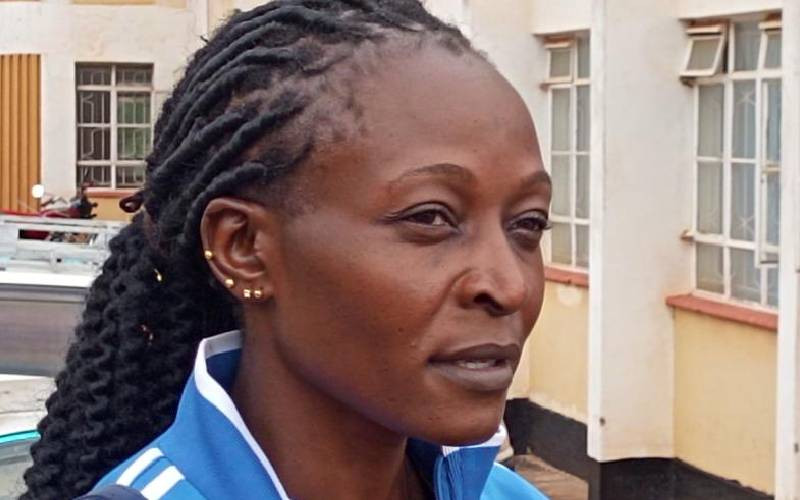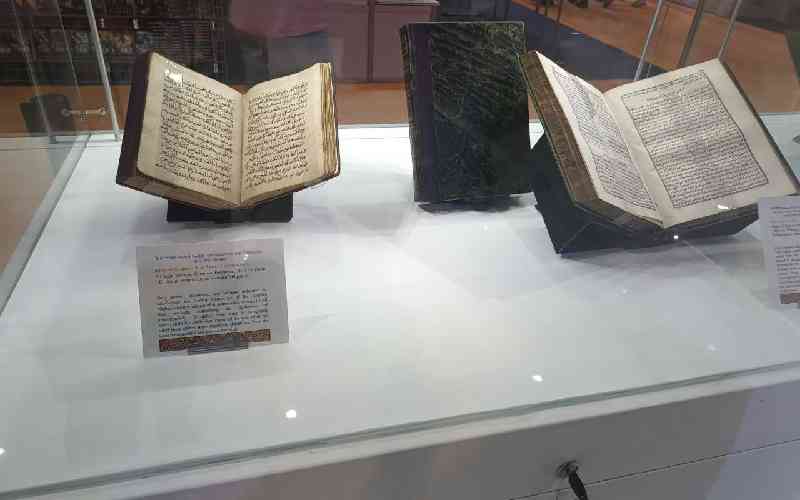 |
|
Kilgoris oral artist, Mzee Ole Sapuda (right) with his apprentice
Michael Ole Tankoi. PHOTO: ABENEA NDAGO.
|
By Abenea Ndago
Kilgoris, Narok County:
“Naisugaiye means ‘the place that swallowed everything’,” oral artist Mzee Ole Sapuda explains, pointing at the large space beside the road, a few kilometers north-east of Kilgoris Town. The soil is brittle gravel, and a wet patch snakes its way down the mild steepness of the floor. The wet patch – which the old man says has not dried since a certain sin occurred several centuries ago – is the keeper of the moral and essence of the Naisugaiye myth of Kilgoris, Narok County.
According to the Mzee Ole Sapuda and his apprentice-friend Michael Ole Tankoi, the Maasai of Kenya belong to any of the four groups of Purko, Siria, Uasin Gishu, and Muitani. He lives in Transmara West District, Kilgoris Division, Oloidoroisoito Location, of Kilutorri Sub-Location. The Muitani Maasai mainly occupy the area around Kilgoris Town in Kilgoris Constituency of Narok County.
“We the Maasai of the Muitani group are a peace-loving people,” says Ole Sapuda. “Wherever we are, peace defines us.”
Ole Sapuda explains that the existence of the Naisugaiye myth among the Muitani Maasai of Shartuga village, off the Kilgoris-Narok Road is further proof that the Muitani want only the best for their fellow members. They have no time to long for misfortunes to befall fellow members of their community.
“Naisugaiye is constantly crying,” he explains. “The tears mean that the wrong which was committed must never be repeated.”
Ole Sapuda says the Naisugaiye myth revolves around a blind woman who was wronged by her co-wife ‘many, many years ago.’
A polygamous man had a blind wife. People used to go to the farm collectively then, and so the man’s whole family did, leaving the blind woman behind. She felt very hungry around midday, when the sun was up in the sky. She called and called. Her co-wife sneaked back, found her hungry, and very quickly cooked ‘meat’ for her to eat. The blind woman ate and died instantly. It turned out that the ‘meat’ was an after-birth.
Out in the farm fields, people heard a roaring noise. Cattle, sheep, goats, donkeys, chicken…were all lowing, bleating, braying and clucking as the whole ground sank with everything. Even the cook was not spared. This was to punish and condemn the wicked injustice which the co-wife had perpetrated.
It is this timeless message that people from far and wide have been flocking to Naisugaiye to learn from the resident oral artist, Mzee Ole Sapuda.
“Even tourists and secondary schools come here,” says Mr Edwin Ole Rumpe, the local guide. “But the most frequent visitors are universities. Barely a year passes before I receive calls from university lecturers who plan to come.”
He is referring to the Kenyan university syllabus, which requires literature students to go for actual fieldwork where they collect narratives, oral poems, songs, riddles and proverbs for cataloguing and analysis. Encouraged by the Kenya Oral Literature Association (KOLA), the requirement is meant to create awareness among students, of the country’s diversity and rich cultural heritage.
The decision can be traced back to 1968, when Ngugi wa Thiong’o, Taban Lo Liyong, and Henry Owuor-Anyumba changed the University of Nairobi’s ‘English Department’ to ‘Literature Department.’ The aim was to indigenise the study of literature by stressing the importance of oral literature.
Stay informed. Subscribe to our newsletter
Ole Rumpe says that his duty as a guide is riddled with several difficulties. “Planning is very difficult. I help young Kenyans to know about their country. But I cannot rely on this work for survival. The pay is extremely unreliable. I have to move up and down for the sake of our Kenyan students who want to learn. I wish universities could work on ways to pay us reliably. If the information that the learners come here for is important, then why is the person who arranges for the information to come out not important?” he asks.
He says that since issues of culture have these days been devolved to the counties, their Narok County government ought to have a hand in arranging for what they earn from the work.
Oginga Odinga University literature students visited Naisugaiye on October 2, 2013. The task was to investigate the extent to which Maasai oral narratives and songs have been influenced by inter-ethnic conflict in the region. A third-year student at the university’s Kosele Learning Centre, Joel Onyango says he learnt a lot about the Maasai culture.
“I learnt what I couldn’t inside the classroom,” he says. “I did not know that Naisugaiye site really existed. I urge more students to visit, but please do not go with a formed opinion. Your prior assumptions are bound to be proved wrong when you go to the actual field.”
Both the oral artist Mzee Ole Sapuda and the guide Ole Rumpe observe that the site could be tapped for their Narok County to earn more revenue, and for them to gain as individuals whose lives revolve around the Naisugaiye myth.
“The place to begin is repairing our Kilgoris-Narok Road,” says Ole Sapuda, “and then the county should arrange how we earn from the stories we tell.”
 The Standard Group Plc is a
multi-media organization with investments in media platforms spanning newspaper
print operations, television, radio broadcasting, digital and online services. The
Standard Group is recognized as a leading multi-media house in Kenya with a key
influence in matters of national and international interest.
The Standard Group Plc is a
multi-media organization with investments in media platforms spanning newspaper
print operations, television, radio broadcasting, digital and online services. The
Standard Group is recognized as a leading multi-media house in Kenya with a key
influence in matters of national and international interest.
 The Standard Group Plc is a
multi-media organization with investments in media platforms spanning newspaper
print operations, television, radio broadcasting, digital and online services. The
Standard Group is recognized as a leading multi-media house in Kenya with a key
influence in matters of national and international interest.
The Standard Group Plc is a
multi-media organization with investments in media platforms spanning newspaper
print operations, television, radio broadcasting, digital and online services. The
Standard Group is recognized as a leading multi-media house in Kenya with a key
influence in matters of national and international interest.






